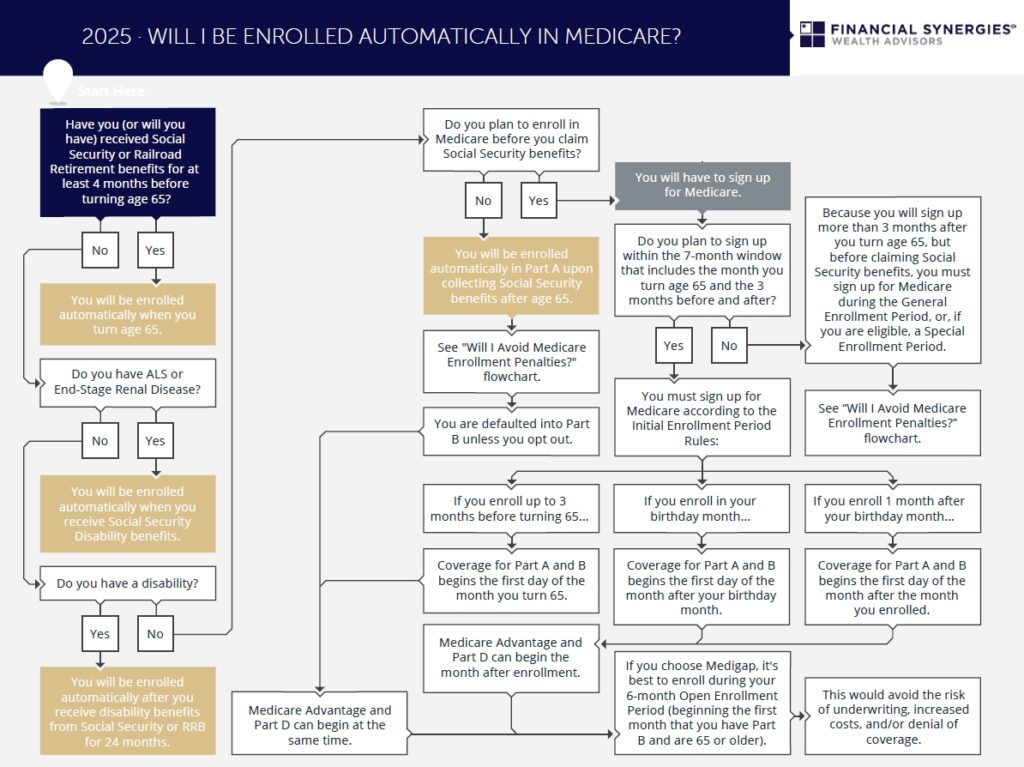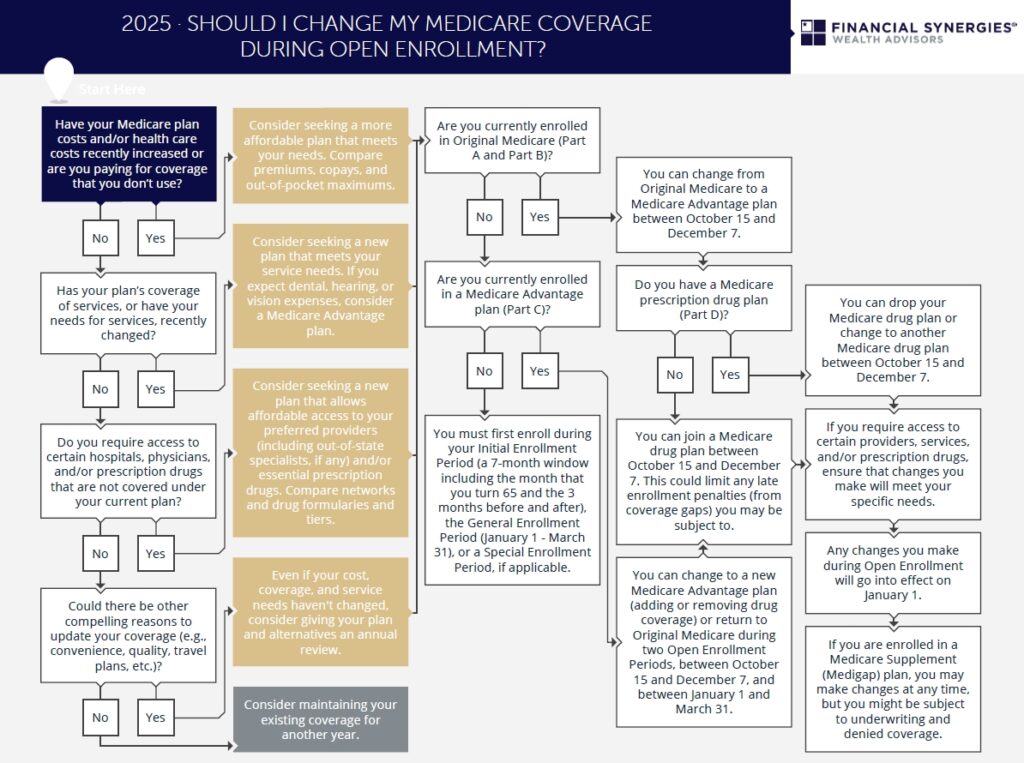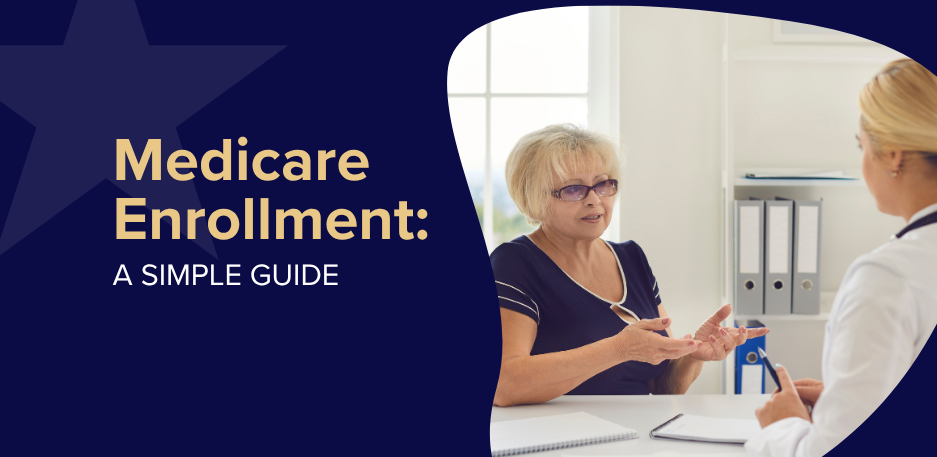- October 2, 2025
- Will Goodson

Medicare Enrollment: A Simple Guide and Key Info
Key Highlights
- Medicare enrollment is automatic for those receiving Social Security benefits but requires manual sign-up for others.
- Your first chance to enroll is during a 7-month Initial Enrollment Period around your 65th birthday.
- Medicare Part A covers hospital stays, while Medicare Part B is for medical insurance.
- Private plans like Medicare Advantage (Part C), Part D (drugs), and Medigap offer additional coverage.
- Missing your enrollment period can lead to lifelong late enrollment penalties on your premiums.
- You can enroll in Original Medicare online, by phone, or at a Social Security office.
Introduction
Navigating Medicare enrollment is a critical step in planning for your future health care. As the federal health insurance program in the United States, Medicare provides essential coverage for millions. Understanding the rules, deadlines, and options is vital to avoid penalties and ensure you have the right health insurance for your needs. This guide will walk you through the key aspects of the enrollment process.
*A note about Open Enrollment starting this October 15th:
The Medicare Open Enrollment period runs each year from October 15 through December 7. This annual enrollment window is for anyone already enrolled in Medicare Part A and/or Part B, including those in Medicare Advantage (Part C) or Part D prescription plans.
What the Enrollment Period Means
During this time, current Medicare beneficiaries can make important changes to their coverage. They can:
- Switch from Original Medicare to a Medicare Advantage plan, or vice versa.
- Change from one Medicare Advantage plan to another.
- Add, switch, or drop prescription drug (Part D) coverage.
- Update coverage to find plans better suited to their needs, budget, or changes in benefits, costs, or provider networks for the upcoming year.
Who Is This For?
This period is designed specifically for people who are already enrolled in Medicare—not for those enrolling for the first time. First-time Medicare enrollees have a separate initial enrollment window based on when they turn 65 or otherwise become eligible.
Why It’s Important
Reviews and changes made during the Medicare Open Enrollment period go into effect January 1 of the following year, so it’s an important opportunity to optimize coverage and costs for the new year. Even if no changes are made, reviewing current coverage is recommended since plans and personal healthcare needs may change annually.
What is Medicare, and how does it work?

Medicare is a federal health insurance program that primarily serves individuals aged 65 and older, but it also extends coverage to certain younger people with disabilities, End-Stage Renal Disease (ESRD), or Amyotrophic Lateral Sclerosis (ALS). As an official government initiative, Medicare helps millions of Americans manage the costs associated with healthcare as they age or face serious medical conditions. However, it’s important to understand that Medicare is not a single, all-encompassing plan; instead, it consists of multiple “parts,” each covering different aspects of medical care.
The two foundational components of the program are Medicare Part A and Part B—collectively known as Original Medicare. Part A covers hospital insurance, including inpatient care in hospitals, skilled nursing facilities, hospice care, and some home health services. Most people do not pay a premium for Part A if they or their spouse paid Medicare taxes while working.
Part B focuses on medical insurance for outpatient care. This includes doctor’s visits, preventive services, diagnostic tests, mental health care, ambulance services, and durable medical equipment. Unlike Part A, enrollment in Part B typically requires a monthly premium.
Beyond Original Medicare, beneficiaries have additional options to enhance or customize their coverage:
- Medicare Advantage (Part C): Offered by private insurance companies approved by Medicare, these plans bundle Parts A and B—and often Part D—into one plan. They may offer extra benefits such as dental, vision, hearing coverage, wellness programs, and sometimes lower out-of-pocket costs.
- Medicare Prescription Drug Coverage (Part D): Also run by private insurers approved by Medicare, these plans help cover the cost of prescription medications. Enrolling in Part D is voluntary but highly recommended if you take regular medications.
- Medigap (Medicare Supplement Insurance): Private supplemental policies designed to help pay some of the healthcare costs not covered by Original Medicare—such as copayments, coinsurance, and deductibles.
It is crucial to assess your health needs and financial situation when choosing among these various parts and plans. Some individuals may benefit from sticking with Original Medicare plus a Medigap policy and standalone Part D plan; others might find more value in an all-in-one Medicare Advantage plan.
Enrollment periods are another key consideration: there are specific windows during which you can sign up for or change your coverage without penalty. Missing these periods could result in higher premiums or gaps in coverage.
A Truly Unique Wealth Management Experience
Let’s create a financial plan and investment strategy that allows you to live the life of your dreams. Schedule your free consultation today to explore tailored financial strategies designed to secure your future!
Understanding Medicare Eligibility
Your Medicare eligibility is typically based on a few key factors. Most people become eligible when they turn 65. However, you may also qualify at a younger age if you have been receiving Social Security disability benefits or certain Railroad Retirement Board benefits for 24 months.
Specific medical conditions also grant earlier eligibility. The following sections will provide more detail on the specific age requirements and qualifications related to disability.
See our free guide: Will I be Enrolled Automatically in Medicare?
Age Requirements and Special Circumstances
Your primary window for Medicare enrollment is the Initial Enrollment Period, which is a 7-month period surrounding your 65th birthday. It begins three months before the month you turn 65, includes your birthday month, and ends three months after.
If you are already receiving Social Security or Railroad Retirement Board retirement benefits at least four months before you turn 65, you will be enrolled in Medicare automatically. If not, you must sign up yourself.
Your coverage start date depends on when you enroll.
- If your birthday is on the first day of the month, your coverage can start the month before your birthday.
- Otherwise, coverage typically begins the month you turn 65, provided you enroll in the preceding months. If you delay enrollment, a Special Enrollment Period may be available if you have other health coverage.
Disability, ALS, and ESRD Qualifications
You do not have to be 65 to qualify for Medicare. Individuals who are entitled to Social Security disability benefits are automatically enrolled in Medicare after a 24-month waiting period. Your coverage will begin on the 25th month of disability benefit entitlement.
Certain conditions have special rules that waive this waiting period.
- ALS (Lou Gehrig’s Disease): If you have ALS, you are entitled to Medicare the very first month you receive your Social Security disability benefits.
- ESRD (End-Stage Renal Disease): If you have ESRD, your eligibility and coverage start date depend on whether you are on dialysis or receiving a kidney transplant.
You will receive a welcome package with your Medicare card in the mail before your coverage starts.
Medicare Enrollment Periods Explained

Enrolling in Medicare must be done during specific timeframes known as enrollment periods. The most important is your Initial Enrollment Period, as missing it without having other qualifying coverage can result in a permanent late enrollment penalty. This penalty is added to your monthly premium for as long as you have coverage.
Understanding the differences between the Initial, General, and Special Enrollment Periods is essential for a smooth transition to Medicare. We will explore what each of these periods entails.
Initial, General, and Special Enrollment Periods
Your first opportunity to sign up is the Initial Enrollment Period (IEP). This is a 7-month window that starts 3 months before your 65th birthday month and ends 3 months after.
If you miss your IEP, you may have to wait for the General Enrollment Period (GEP), which runs from January 1 to March 31 each year. However, coverage will not start until the month after you enroll.
A Special Enrollment Period (SEP) is available for those who delayed enrollment because they had health coverage from an employer. This allows you to enroll without penalty.
| Enrollment Period | When It Occurs |
|---|---|
| Initial Enrollment Period | The 7-month period around your 65th birthday or 25th month of disability. |
| General Enrollment Period | January 1 – March 31 each year, if you missed your initial window. |
| Special Enrollment Period | Triggered by life events, like losing employer health coverage. |
See our free guide: Should I Change My Medicare Coverage During Open Enrollment?
What Happens If You Miss Your Enrollment Window?
Failing to sign up for Medicare during your Initial Enrollment Period can have long-lasting financial consequences. If you do not have other qualifying health coverage (like from an employer), you will likely face a late enrollment penalty.
This is not a one-time fee. The Part B penalty is a monthly late enrollment penalty added to your premium for as long as you have the coverage.
- Your monthly premium for Part B may increase by 10% for each full 12-month period you were eligible but did not enroll.
- This can result in a permanently higher premium, impacting your retirement budget.
To avoid this, it is critical to track your eligibility dates and enroll on time. Consulting a financial planner can help integrate these potential costs into your long-term high net worth financial planning.
How to Enroll in Medicare Part A and Part B

The process for Medicare enrollment in Part A and Part B depends on your situation. Medicare Part A covers inpatient hospital stays, skilled nursing facility care, hospice, and some home health care. Medicare Part B covers outpatient care, doctor visits, preventive services, and some home health care as well. If you are already receiving Social Security benefits before you turn 65, you will be automatically enrolled. You will receive your Medicare card in the mail about three months before your coverage starts.
If you are not receiving these benefits, you must enroll yourself. There are several convenient methods to complete your application, which we will cover next.
Online, Phone, and In-Person Application Methods
The Social Security Administration (SSA) offers multiple ways to apply for Medicare, giving you flexibility. The fastest and easiest method is through online enrollment on the official Social Security website: https://www.ssa.gov/medicare/sign-up
If you prefer speaking to someone, you have other options.
- By Phone: You can call the Social Security Administration at 1-800-772-1213. TTY users can call 1-800-325-0778.
- In Person: You can visit your local Social Security office to apply.
If you or your spouse worked for a railroad, you should contact the Railroad Retirement Board directly to enroll.
Required Documents and Steps for Enrolling
While the specific required documents can vary, the enrollment process is straightforward. The key is to have your personal information ready before you start your application with the official government organization.
The most important step, especially for online enrollment, is setting up your My Social Security Account. This secure portal is where you will manage your application and benefits.
- Create your secure My Social Security Account online.
- Complete the Medicare application.
- Watch for your welcome package and Medicare card in the mail, which should arrive in about two to three weeks.
Having this health insurance in place is a foundational part of your financial plan.
How to enroll in Medicare Advantage (Part C) or Medicare Part D plans
Enrolling in a Medicare Advantage (Part C) or a Medicare Part D plan is different from enrolling in Original Medicare. Medicare Part C, also known as Medicare Advantage, is an all-in-one alternative to Original Medicare that includes coverage for hospital services, medical services, and often includes additional benefits like vision and dental care. Medicare Part D provides prescription drug coverage to help lower your medication costs.
These plans are offered by private insurance companies approved by Medicare. To get this coverage, you must first be enrolled in Original Medicare.
You will need to research and join a plan directly from an insurance provider during a valid enrollment period. The following sections explain how to sign up for these specific plans.
How to enroll in a Medicare Advantage (Part C) plan
To enroll in a Medicare Advantage (Part C) plan, you must first be enrolled in both Medicare Part A and Part B. These plans bundle your Original Medicare benefits and often include extra services like dental, vision, and drug coverage.
Once you have Parts A and B, you can follow these steps:
- Find insurance companies that offer Part C plans in your service area.
- Compare the benefits, costs, and provider networks to find the plan that best fits your health care needs and budget.
You can then enroll directly with the insurance provider, either online, over the phone, or with a licensed agent. You can also make changes during the Medicare Advantage Open Enrollment Period. This detailed approach is crucial for high-net-worth families looking to optimize their healthcare coverage.
How to enroll in a Medicare Part D plan
A Medicare Part D plan provides coverage for prescription drugs, which is not included in Original Medicare. To be eligible, you must be enrolled in either Medicare Part A or Part B. You do not need both. These plans are sold by private insurance companies, and you enroll directly with the provider of your choice.
You should compare the available Part D plans in your area, paying close attention to which of your medications are covered and what the monthly premiums and copayments will be. The annual Open Enrollment Period, from October 15 to December 7, is the main time you can join, switch, or drop a Part D plan.
How to enroll in Medicare Supplement insurance (Medigap) plans

Medicare Supplement insurance, also known as Medigap, helps pay for some of the out-of-pocket costs that Original Medicare doesn’t cover, like deductibles and coinsurance. These policies are sold by private companies. The best time to buy a Medigap plan is during your 6-month Medigap Open Enrollment Period. This period starts on the first day of the month you are 65 or older and enrolled in Part B.
During this window, you are guaranteed the right to buy any Medigap plan sold in your state, regardless of your health status. If you apply outside of this period, insurers can deny you coverage or charge higher monthly premiums based on your medical history. You enroll in a Medigap plan by contacting the private insurance company directly.
Conclusion
Navigating Medicare enrollment can be complex, but understanding the key components is essential for securing your benefits. From eligibility criteria to the various enrollment periods, each step plays a crucial role in ensuring you receive the coverage you need. Be sure to gather the necessary documents and familiarize yourself with the application methods to streamline your enrollment process.
Remember, missing your enrollment window can lead to penalties, so it’s vital to stay informed and proactive. If you have any questions or need guidance through the enrollment process, don’t hesitate to reach out to us directly. Your health and well-being deserve the best coverage possible.
Frequently Asked Questions
When am I eligible to sign up for Medicare?
You are typically eligible for Medicare when you turn 65. You may also qualify earlier if you have been receiving Social Security disability benefits for 24 months or have a diagnosis of End-Stage Renal Disease (ESRD) or ALS.
Do Social Security Benefits Affect My Medicare Enrollment?
Yes, they do. If you are already receiving Social Security or Railroad Retirement Board benefits at least four months before your 65th birthday, you will be automatically enrolled in Medicare Part A and Part B. Otherwise, you will need to sign up yourself.
Is Enrolling in Medicare Different From Joining a Medicare Plan?
Yes. Enrolling in Medicare refers to signing up for Original Medicare (Parts A and B) through the government. Joining a Medicare plan means choosing a private health insurance option, like a Medicare Advantage (Part C) or Part D plan, from an insurance company.
How Can I Change or Renew My Medicare Plan After Enrolling?
You can review and change your Medicare choices annually during the Open Enrollment Period from October 15 to December 7. This is your chance to switch between Medicare Advantage plans or change your Part D prescription drug coverage for the upcoming year.
Can I apply for Medicare online or do I need to visit an office?
You have multiple options. The Social Security Administration encourages online enrollment through its gov website as the fastest method. You can also apply over the phone or in person by contacting your local Social Security office.
Sources:
https://www.ssa.gov/benefits/medicare/
Concerns or questions about your financial plan or medical coverage? Contact Financial Synergies today.
We are a boutique, financial advisory and total wealth management firm with over 35 years helping clients navigate markets and developing custom financial plans. To learn more about our approach to financial planning please reach out to us. One of our seasoned advisors would be happy to help you build a custom financial plan to help ensure you accomplish your financial goals and objectives. Schedule a conversation with us today.
More relevant articles by Financial Synergies:
- 2024 Important Tax Numbers: A Handy Guide
- Medicare Open Enrollment Begins Oct. 15th. What You Need to Know.
- How COVID-19 Impacts Medicare Coverage
Blog Disclosures
This content, which may contain security-related opinions and/or information, is provided for informational purposes only and should not be relied upon in any manner as professional advice, or an endorsement of any practices, products or services. There can be no guarantees or assurances that the views expressed here will be applicable for any particular facts or circumstances, and should not be relied upon in any manner. You should consult your own financial advisors as to legal, business, tax, and other related matters concerning any investment.
The commentary in this “post” (including any related blogs, videos, and social media) reflects the personal opinions, viewpoints, and analyses of the Financial Synergies Wealth Advisors, Inc. employees providing such comments, and should not be regarded as the views of Financial Synergies Wealth Advisors, Inc. or its respective affiliates or as a description of advisory services provided by Financial Synergies Wealth Advisors, Inc. or performance returns of any Financial Synergies Wealth Advisors, Inc. client.
Any opinions expressed herein do not constitute or imply endorsement, sponsorship, or recommendation by Financial Synergies Wealth Advisors, Inc. or its employees. The views reflected in the commentary are subject to change at any time without notice.
Nothing on this website or Blog constitutes investment or financial planning advice, performance data or any recommendation that any particular security, portfolio of securities, transaction or investment strategy is suitable for any specific person. It also should not be construed as an offer soliciting the purchase or sale of any security mentioned. Nor should it be construed as an offer to provide investment advisory services by Financial Synergies Wealth Advisors, Inc.
Any mention of a particular security and related performance data is not a recommendation to buy or sell that security. Financial Synergies Wealth Advisors, Inc. manages its clients’ accounts using a variety of investment techniques and strategies, which are not necessarily discussed in the commentary. Investments in securities involve the risk of loss. Past performance is no guarantee of future results.
Any charts provided here or on any related Financial Synergies Wealth Advisors, Inc. personnel content outlets are for informational purposes only, and should also not be relied upon when making any investment decision. Any indices referenced for comparison are unmanaged and cannot be invested into directly. As always please remember investing involves risk and possible loss of principal capital; please seek advice from a licensed professional. Any projections, estimates, forecasts, targets, prospects and/or opinions expressed in these materials are subject to change without notice and may differ or be contrary to opinions expressed by others. Information in charts have been obtained from third-party sources and data, and may include those from portfolio securities of funds managed by Financial Synergies Wealth Advisors, Inc. While taken from sources believed to be reliable, Financial Synergies Wealth Advisors, Inc. has not independently verified such information and makes no representations about the enduring accuracy of the information or its appropriateness for a given situation. All content speaks only as of the date indicated.
Financial Synergies Wealth Advisors, Inc. is a registered investment adviser. Advisory services are only offered to clients or prospective clients where Financial Synergies Wealth Advisors, Inc. and its representatives are properly licensed or exempt from licensure. Investments in securities involve the risk of loss. Past performance is no guarantee of future results.





